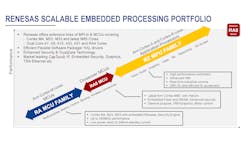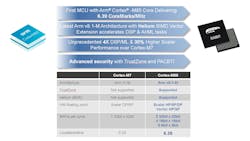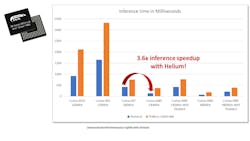The Cortex-M85 Makes Its Debut
What you’ll learn:
- Why the Arm Cortex-M85 is significant..
- What the Renesas RA8 family brings to the table.
The Renesas RA8 family of microcontrollers, based on the Arm Cortex-M85 architecture, fills the gap between existing Cortex-M solutions and higher-end Cortex-A application processors (Fig. 1). The Cortex-M85 offers advanced functionality, including integrated artificial-intelligence/machine-learning (AI/ML) hardware acceleration. In the video (above), I talked with Kavita Char, Principal Product Marketing Manager at Renesas, about the company’s latest chip family.
The RA8 main feature set is provided by the Arm V8.1-M architecture used in the Cortex-M85 (Fig. 2). The platform can deliver 6.39 CoreMarks/MHz and run at speeds up to 480 MHz. The architecture includes TrustZone support as well as Helium, which supplies the AI/ML acceleration. This combination delivers a significant performance boost to general and AI/ML applications.
The architecture adds 150 scalar and vector instructions to the mix along with new floating-point support. The V8.1-M architecture includes Pointer Authentication and Branch Target Identification (PACBTI) support designed to mitigate software attacks that utilize memory safety violations to cause memory corruption. The chips are equipped to prevent differential power analysis and simple power analysis (DPA/SPA) side channel attacks.
The family also provides PSA Certified Level 2 + Secure Element (SE) plus NIST CAVP and FIPS 140-3 certifications. The chips incorporate hardware root-of-trust and secure boot. A ROM provides first boot stage. The Renesas Security IP (RSIP-E51A) adds cryptographic acceleration.
The MCUs come with up to 2 MB of flash, 128 kB of data flash, 1 MB of SRAM, and 1 kB of standby SRAM. There’s ECC functionality and the Octal SPI interface supports decryption-on-the-fly (DOTF) as well as eXecute-in-place (XIP).
The family provides 12-bit ADC and 12-bit DAC support along with a pair of high-speed comparators and a built-in temperature sensor. There's the usual mix of timers and serial ports along with CAN FD and Ethernet support. A CEU camera interface is included to handle video or image input.
The RA8 family works within a wide power range (1.68 to 3.6 V DC). This is handled by an on-chip DC-DC converter. Numerous sleep modes help preserve battery power in embedded applications.
Helium delivers a significant AI/ML boost, offering more performance with lower power requirements or even higher performance when running at full speed (Fig. 3).
Developers can get started with the RA8 family using the EK-RA8M1 evaluation kit (Fig. 4). The development board includes single wire debug (SWD) and JTAG support. There are two SeeedGrove interfaces and two Digilent Pmod ports. An Arduino Uno R3 header is part of the package along with a mikroBUS socket. A SparFun Qwiic connection provides I2C support. A 64-MB octa-flash chip brings additional storage. CAN-FD and Ethernet connections are included as well.
The chips, available in LQFP and BGA packages, can handle temperatures from –40 to 125°C.
About the Author
William G. Wong
Senior Content Director - Electronic Design and Microwaves & RF
I am Editor of Electronic Design focusing on embedded, software, and systems. As Senior Content Director, I also manage Microwaves & RF and I work with a great team of editors to provide engineers, programmers, developers and technical managers with interesting and useful articles and videos on a regular basis. Check out our free newsletters to see the latest content.
You can send press releases for new products for possible coverage on the website. I am also interested in receiving contributed articles for publishing on our website. Use our template and send to me along with a signed release form.
Check out my blog, AltEmbedded on Electronic Design, as well as his latest articles on this site that are listed below.
You can visit my social media via these links:
- AltEmbedded on Electronic Design
- Bill Wong on Facebook
- @AltEmbedded on Twitter
- Bill Wong on LinkedIn
I earned a Bachelor of Electrical Engineering at the Georgia Institute of Technology and a Masters in Computer Science from Rutgers University. I still do a bit of programming using everything from C and C++ to Rust and Ada/SPARK. I do a bit of PHP programming for Drupal websites. I have posted a few Drupal modules.
I still get a hand on software and electronic hardware. Some of this can be found on our Kit Close-Up video series. You can also see me on many of our TechXchange Talk videos. I am interested in a range of projects from robotics to artificial intelligence.




